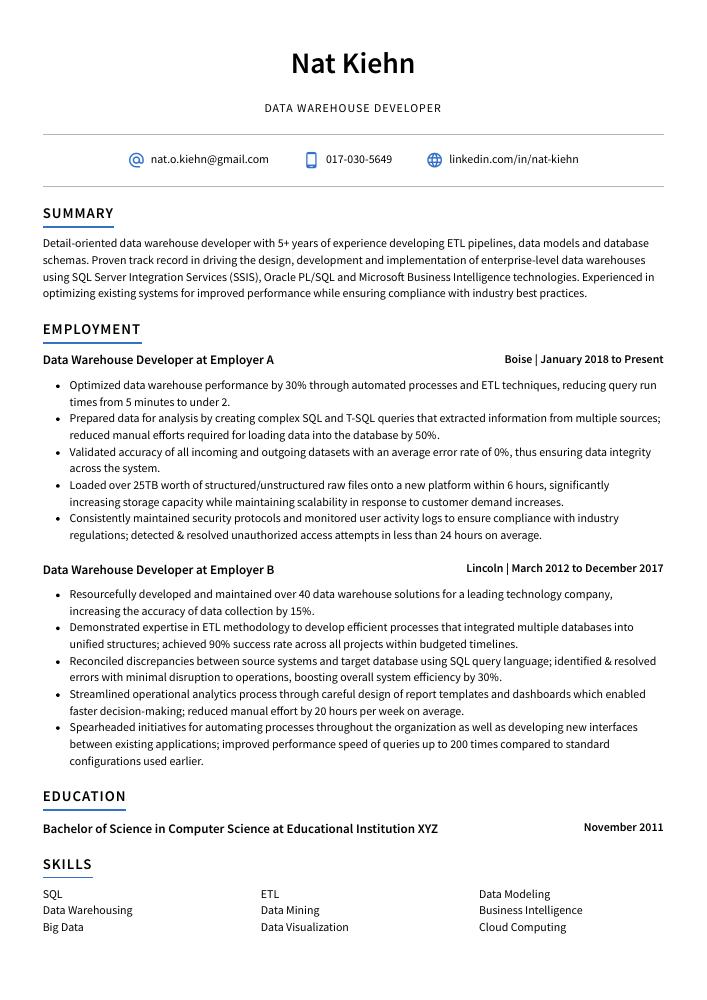Data Warehouse Developer Resume Guide
Data warehouse developers design and implement complex data warehouses that store, analyze and report on large amounts of data. They develop ETL (extract, transform, load) processes to integrate data from multiple sources into a single repository while ensuring the accuracy of the information. Additionally, they create reports using business intelligence tools to help organizations make informed decisions based on their analysis.
Data warehouses are your specialty. You have the skills to design and develop them better than anyone else, but potential employers don’t know that yet. Writing a resume that highlights your experience is key to showing them what you can do.
This guide will walk you through the entire process of creating a top-notch resume. We first show you a complete example and then break down what each resume section should look like.
Table of Contents
The guide is divided into sections for your convenience. You can read it from beginning to end or use the table of contents below to jump to a specific part.
Data Warehouse Developer Resume Sample
Nat Kiehn
Data Warehouse Developer
nat.o.kiehn@gmail.com
017-030-5649
linkedin.com/in/nat-kiehn
Summary
Detail-oriented data warehouse developer with 5+ years of experience developing ETL pipelines, data models and database schemas. Proven track record in driving the design, development and implementation of enterprise-level data warehouses using SQL Server Integration Services (SSIS), Oracle PL/SQL and Microsoft Business Intelligence technologies. Experienced in optimizing existing systems for improved performance while ensuring compliance with industry best practices.
Experience
Data Warehouse Developer, Employer A
Boise, Jan 2018 – Present
- Optimized data warehouse performance by 30% through automated processes and ETL techniques, reducing query run times from 5 minutes to under 2.
- Prepared data for analysis by creating complex SQL and T-SQL queries that extracted information from multiple sources; reduced manual efforts required for loading data into the database by 50%.
- Validated accuracy of all incoming and outgoing datasets with an average error rate of 0%, thus ensuring data integrity across the system.
- Loaded over 25TB worth of structured/unstructured raw files onto a new platform within 6 hours, significantly increasing storage capacity while maintaining scalability in response to customer demand increases.
- Consistently maintained security protocols and monitored user activity logs to ensure compliance with industry regulations; detected & resolved unauthorized access attempts in less than 24 hours on average.
Data Warehouse Developer, Employer B
Lincoln, Mar 2012 – Dec 2017
- Resourcefully developed and maintained over 40 data warehouse solutions for a leading technology company, increasing the accuracy of data collection by 15%.
- Demonstrated expertise in ETL methodology to develop efficient processes that integrated multiple databases into unified structures; achieved 90% success rate across all projects within budgeted timelines.
- Reconciled discrepancies between source systems and target database using SQL query language; identified & resolved errors with minimal disruption to operations, boosting overall system efficiency by 30%.
- Streamlined operational analytics process through careful design of report templates and dashboards which enabled faster decision-making; reduced manual effort by 20 hours per week on average.
- Spearheaded initiatives for automating processes throughout the organization as well as developing new interfaces between existing applications; improved performance speed of queries up to 200 times compared to standard configurations used earlier.
Skills
- SQL
- ETL
- Data Modeling
- Data Warehousing
- Data Mining
- Business Intelligence
- Big Data
- Data Visualization
- Cloud Computing
Education
Bachelor of Science in Computer Science
Educational Institution XYZ
Nov 2011
Certifications
Certified Data Warehouse Developer
TDWI (The Data Warehousing Institute
May 2017
1. Summary / Objective
Your resume summary/objective should be a concise summary of your data warehouse development skills and experience. Include the programming languages, frameworks, and databases you are most proficient in; any certifications or awards that demonstrate your expertise; as well as how you have used data warehousing to improve business operations at previous companies. This will give employers an overview of why they should consider hiring you for their open position.
Below are some resume summary examples:
Seasoned data warehouse developer with 8+ years of experience designing and developing data warehouses for Fortune 500 companies. Skilled in creating ETL pipelines, building cubes, and optimizing SQL performance. At XYZ Corporation designed a multi-dimensional cube that decreased query time from 5 minutes to 2 seconds while increasing accuracy by 20%. Received an award for “outstanding contribution” due to the successful completion of this project.
Energetic data warehouse developer with 5+ years of experience in designing and developing data warehouses, ETL processes, and reporting solutions. Expertise in leveraging various technologies to create high-performance systems that can effectively manage the storage and retrieval of large volumes of data. Seeking to leverage knowledge base at ABC Technologies to deliver reliable databases for their clients.
Committed data warehouse developer with 5+ years of experience designing and developing data warehouses, ETL pipelines, databases, and BI tools using Oracle Database 12c. Experienced in transforming complex business requirements into efficient solutions to generate actionable insights for senior stakeholders. Skilled at streamlining workflows through automation that reduced the manual effort by 40%.
Determined data warehouse developer with 5+ years of experience in designing, developing, and maintaining data warehouses. Experienced working with Oracle 11g and 12c databases as well as MS SQL Server. Skilled at creating stored procedures for ETL processes using T-SQL & PL/SQL scripts. Proven ability to analyze complex business requirements and develop secure solutions that meet customer needs.
Amicable and experienced data warehouse developer with 7+ years of experience in developing, testing, and maintaining ETL processes for large organizations. Proven track record of designing efficient data warehouses to support business decision-making. Looking to join ABC Tech as a Data Warehouse Developer to use my expertise building reliable solutions tailored towards the company’s needs.
Well-rounded data warehouse developer with 8+ years of experience in the design and development of data warehouses. Experienced in building ETL processes, developing dimensional models, creating stored procedures, and deploying dashboards for enterprise-level clients. Skilled at leveraging advanced analytics to identify patterns that can help businesses make more informed decisions.
Diligent data warehouse developer with 5+ years of experience in designing data models, building ETL processes, and developing custom solutions for reporting needs. At ABC Corp., created an automated process that reduced time spent on manual data entry by up to 50%. Seeking to leverage proven skillset and expertise towards a Data Warehouse Developer position at XYZ Tech.
Professional data warehouse developer with 8+ years of experience developing, maintaining and troubleshooting data warehouses. Skilled in database design, ETL processes, back-end development and report creation. Seeking to join ABC Tech as a Data Warehouse Developer to utilize my knowledge of databases and analytics to create efficient solutions for their customers.
2. Experience / Employment
In the experience section, you should list your employment history in reverse chronological order. It’s best to use bullet points here as it makes the information easier to digest quickly.
When writing these bullet points, think about what tasks and responsibilities you had for each role and the results that were achieved from them. For example, instead of saying “Developed a data warehouse,” you could say something like “Designed an efficient ETL process using SSIS which resulted in a 20% reduction in loading time.”
To write effective bullet points, begin with a strong verb or adverb. Industry specific verbs to use are:
- Designed
- Implemented
- Optimized
- Automated
- Monitored
- Extracted
- Loaded
- Transformed
- Validated
- Reconciled
- Analyzed
- Documented
- Troubleshot
- Administered
- Secured
Other general verbs you can use are:
- Achieved
- Advised
- Assessed
- Compiled
- Coordinated
- Demonstrated
- Developed
- Expedited
- Facilitated
- Formulated
- Improved
- Introduced
- Mentored
- Participated
- Prepared
- Presented
- Reduced
- Reorganized
- Represented
- Revised
- Spearheaded
- Streamlined
- Structured
- Utilized
Below are some example bullet points:
- Presented complex data warehouse solutions to internal stakeholders, resulting in an estimated $10,000 cost savings over the next year.
- Formulated strategies for capturing and analyzing large volumes of structured and unstructured data from multiple sources; increased accuracy by 20%.
- Transformed raw source data into business intelligence assets using SQL Server Integration Services (SSIS), ETL tools, T-SQL queries and Data Warehousing techniques.
- Monitored system performance on a daily basis while troubleshooting any issues that arose with reporting services or cube processing; reduced downtime by 30 hours per month on average.
- Confidently handled customer inquiries regarding warehouse operations & processes while driving new initiatives aimed at improving quality assurance metrics across all projects.
- Revised the data warehouse architecture, resulting in a decrease of 20% in query times and improved data accuracy by 95%.
- Implemented ETL processes for over 10 databases using both SQL and Python; reduced development costs by $4,500 per month.
- Advised the IT team on best practices for integrating new applications into existing environments without disrupting service availability or performance levels.
- Troubleshot complex database issues such as deadlocks, index fragmentation and poor query plan execution to optimize system performance up to 45%.
- Effectively managed multiple projects simultaneously with an average completion rate of 2 days ahead of schedule while meeting all quality standards set forth by clients/stakeholders.
- Automated data querying process to improve data access speed by 30%, reducing run time from 5 hours to 2.5 hours per query.
- Efficiently compiled and analyzed large volumes of structured and unstructured data using SQL, Python, Java Script & MS Excel; enabled organization to gain valuable customer insights for improved marketing campaigns.
- Reorganized existing databases into a single, unified platform resulting in an increase of 25% efficiency when retrieving information for reports and analytics projects.
- Participated in the development of ETL (Extract-Transform-Load) processes that allowed raw data from multiple sources to be integrated with the company’s warehouse system within 3 weeks’ time frame instead of 4 months previously needed before automation was established.
- Led creation & implementation of numerous new programs that increased overall accuracy rate during warehousing operations by 15%.
- Assessed user requirements and implemented data warehouse solutions to meet business needs, resulting in an increase of 18% in system performance.
- Thoroughly tested ETL processes for accuracy and completeness before deploying into production environments; reduced errors by 20%.
- Secured databases with various encryption techniques to protect sensitive information from unauthorized access; successfully passed all internal security audits.
- Designed efficient dimensional models using SQL Server Analysis Services (SSAS) cubes that enabled faster analysis of large amounts of data while consuming minimal resources.
- Administered existing relational databases including backups & recovery operations as well as optimization efforts which led to a decrease in query times by 10%.
- Utilized SQL, PL/SQL and ETL processes to design, develop and implement data warehouses for 6+ clients; enabled organization-wide access of business intelligence reports with 35% faster execution speed.
- Actively maintained warehouse environments by troubleshooting issues related to databases & stored procedures; restored system performance optimization within 3 hours in 80% of cases.
- Expedited the development process by creating custom scripts that automated daily tasks such as warehousing updates, indexing maintenance & batch job scheduling; reduced manual input time by 45%.
- Structured effective data models for analytical purposes based on customer requirements using dimensional modeling techniques; designed 10+ star schemas saving an average 23 hours each month per project.
- Developed comprehensive documentation including user manuals and system diagrams to ensure smooth transition from development to production stage for all projects.
- Analyzed large datasets to identify patterns and trends, which enabled the organization to make better informed decisions that resulted in a 15% increase in revenue.
- Represented data using interactive dashboards and visualizations for stakeholders across various departments; created over 100 custom reports used by executives & managers on a daily basis.
- Facilitated seamless communication between different databases within the company’s internal systems, allowing for streamlined information sharing and reduced manual input time by 75%.
- Meticulously designed complex ETL processes from scratch to extract, transform & load large amounts of structured/unstructured data into multiple platforms with 99% accuracy rate.
- Improved system performance through optimization techniques such as indexing tables and restructuring queries; decreased query response times by 70%.
- Achieved a 50% increase in data warehouse accuracy by utilizing Extract, Transform and Load (ETL) processes to automate the loading of data from multiple sources.
- Documented technical requirements for 10+ projects involving design, development and implementation of various data warehouses; created detailed system flow diagrams and documentation files.
- Coordinated with IT teams to ensure that projects were completed on time while adhering to all quality assurance guidelines; minimized project timelines by 6%.
- Competently designed interactive dashboards using Tableau or Power BI in order to provide stakeholders with visual insights into their datasets across disparate systems & databases.
- Reduced costs associated with manual ETL operations through automated scheduling tasks built within SSIS, resulting in a reduction of $4,000/monthly expenditure on labor resources alone.
- Introduced data warehouse environments and ETL processes to 20+ team members, ensuring that everyone was up-to-date on the latest technologies.
- Extracted data from various sources such as CRM systems, databases and flat files into a unified structure within the data warehouse; increased accuracy of extracted records by 40%.
- Mentored junior staff on developing efficient queries for extracting large volumes of structured/unstructured data; saved an average 4 hours per query development task in total over 3 months.
- Accurately developed 5+ reports with business intelligence tools like Tableau & Microsoft Power BI to provide insights based off acquired datasets; generated $1 million worth of new opportunities through these reports in 6 months.
3. Skills
Skill requirements will differ from one employer to the next; this can easily be ascertained from the job posting. Organization A may require the candidate to have experience with Oracle and Microsoft SQL Server, while Organization B may require Hadoop and Apache Spark.
It is essential to tailor the skills section of your resume so that it matches each job you are applying for; this way, you can increase your chances of being selected by an applicant tracking system (ATS). An ATS is a computer program used by many companies nowadays which scans resumes for certain keywords before passing them on to a human.
In addition to just listing skills in this section, be sure to discuss them further in other areas such as the summary or experience sections.
Below is a list of common skills & terms:
- Big Data
- Business Intelligence
- Cloud Computing
- Data Mining
- Data Modeling
- Data Security
- Data Visualization
- Data Warehousing
- ETL
- SQL
4. Education
Adding an education section to your resume will depend on how far along you are in your career. If you just graduated and have no prior experience, mention your education below your resume objective. However, if you have been working as a data warehouse developer for years with plenty of responsibilities to showcase, omitting the education section is perfectly fine.
If an education section is included, try to list courses and subjects related to the data warehouse role that demonstrate expertise in the field.
Bachelor of Science in Computer Science
Educational Institution XYZ
Nov 2011
5. Certifications
Certifications are a great way to demonstrate your knowledge and expertise in a particular field. They are also an excellent way of showing employers that you have taken the initiative to stay up-to-date with industry trends and standards.
Including certifications on your resume can help set you apart from other applicants, so make sure to list any relevant ones for the job position you are applying for. This will show potential employers that you have gone above and beyond what is expected of them.
Certified Data Warehouse Developer
TDWI (The Data Warehousing Institute
May 2017
6. Contact Info
Your name should be the first thing a reader sees when viewing your resume, so ensure its positioning is prominent. Your phone number should be written in the most commonly used format in your country/city/state, and your email address should be professional.
You can also choose to include a link to your LinkedIn profile, personal website, or other online platforms relevant to your industry.
Finally, name your resume file appropriately to help hiring managers; for Nat Kiehn, this would be Nat-Kiehn-resume.pdf or Nat-Kiehn-resume.docx.
7. Cover Letter
Including a cover letter with your resume is an important step in the job search process. It gives you the opportunity to showcase more of your personality and explain why you are a great fit for the role.
Cover letters typically include 2 to 4 paragraphs that provide additional detail about who you are and what skills or experiences make you stand out from other applicants. Although not required, writing one can be highly beneficial when applying for jobs as it will help recruiters gain deeper insights into who you are as a professional.
Below is an example cover letter:
Dear Melyssa,
I am writing to apply for the Data Warehouse Developer position at XYZ Corporation. As a data warehouse developer with 5+ years of experience designing and implementing data warehouses, I am confident I will be an asset to your organization.
My experience includes developing ETL processes using SSIS, creating reports and dashboards in SSRS, and designing dimensional databases using Kimball methodology. I have also worked with big data platforms such as Hadoop and Hive. In my previous role, I was responsible for end-to-end development of a data warehouse from scratch which included requirements gathering, architecture design, ETL development, testing, deployment, and post-deployment support.
I believe my skills and experience make me an ideal candidate for this position. I am looking forward to the opportunity to utilize my skills in a challenging environment where I can continue to learn new technologies and grow professionally.
Thank you for your time and consideration. If you have any questions or would like additional information about my qualifications please do not hesitate to contact me at [phone number] or [email address].
Sincerely,
Nat
Data Warehouse Developer Resume Templates
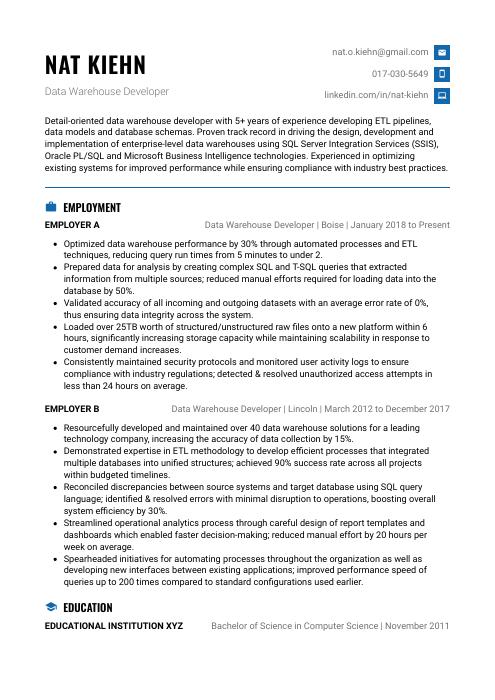 Echidna
Echidna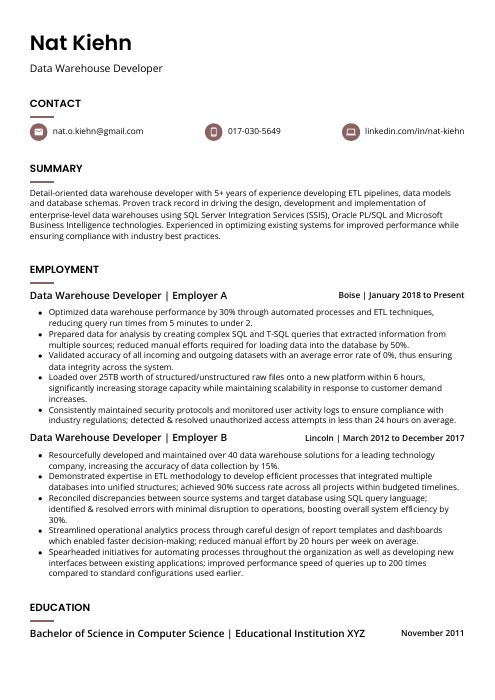 Fossa
Fossa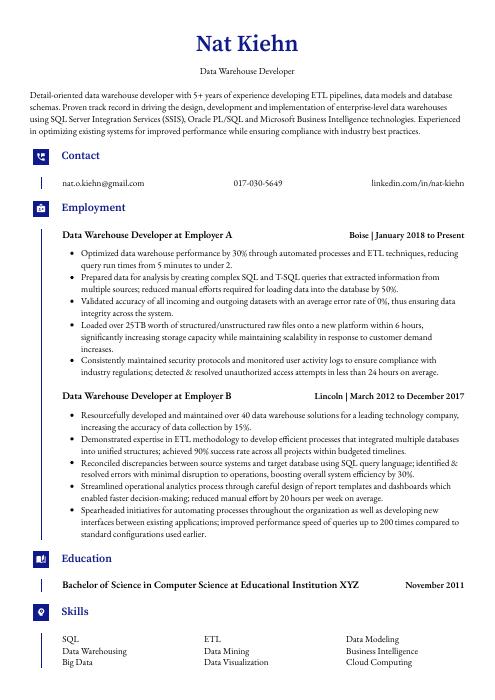 Gharial
Gharial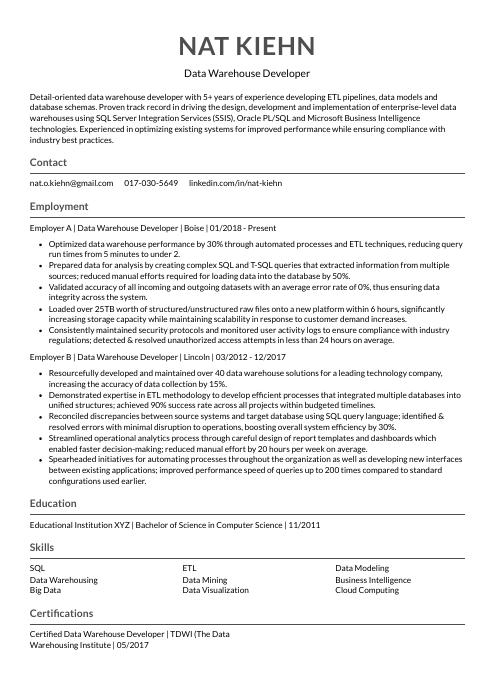 Indri
Indri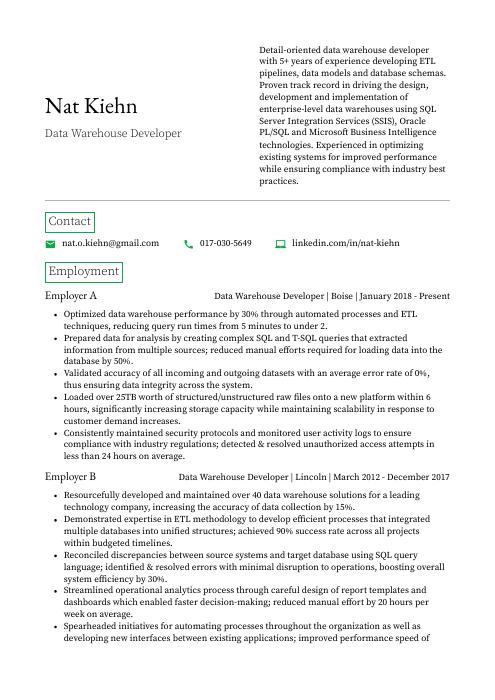 Quokka
Quokka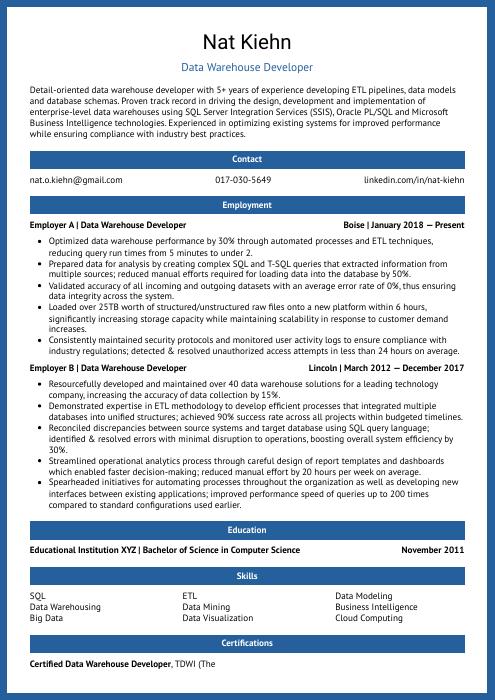 Ocelot
Ocelot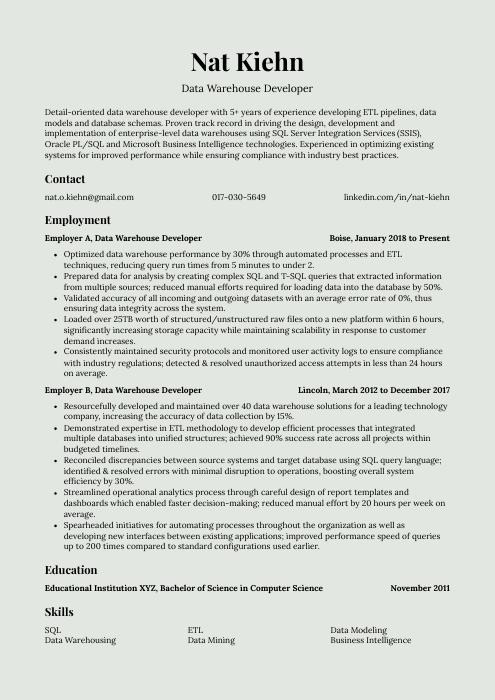 Saola
Saola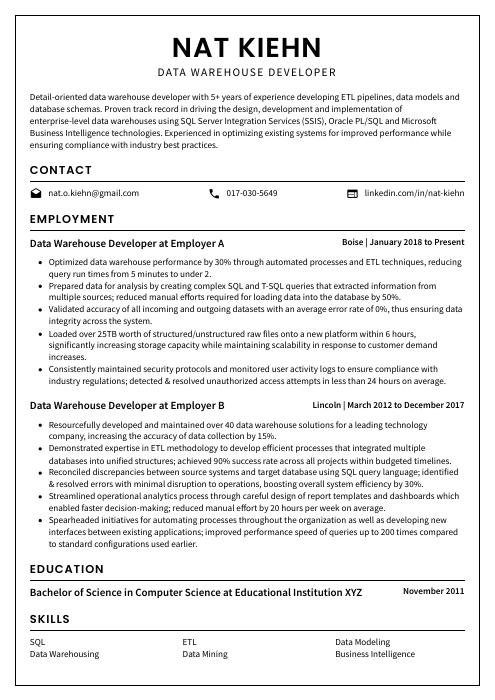 Cormorant
Cormorant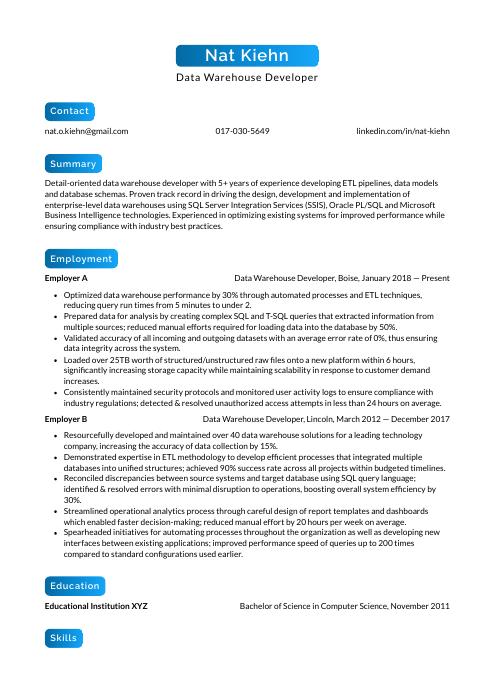 Kinkajou
Kinkajou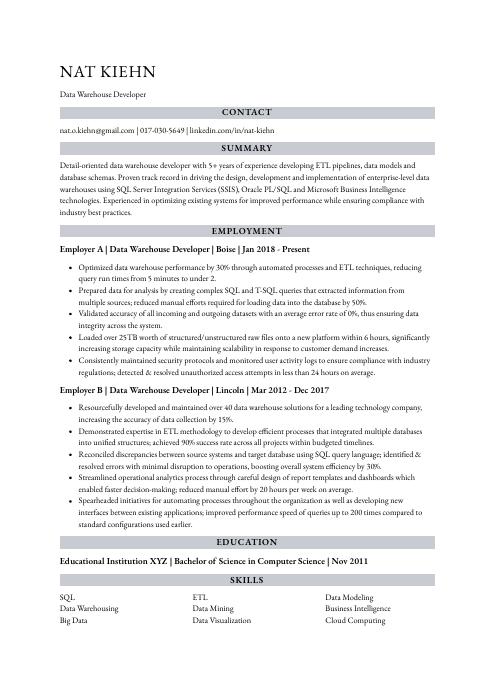 Numbat
Numbat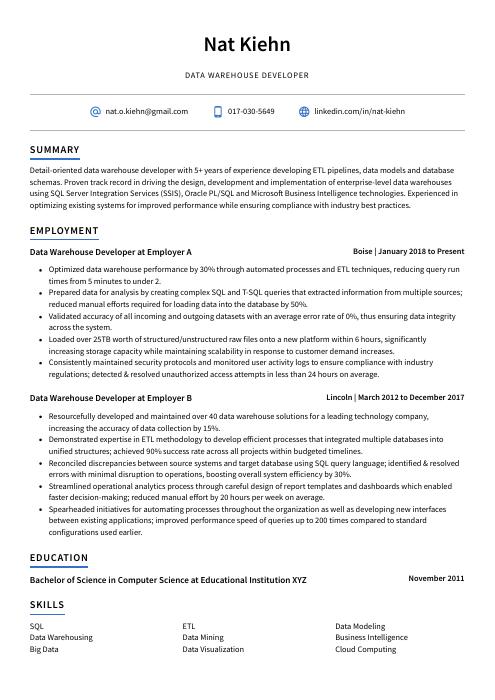 Axolotl
Axolotl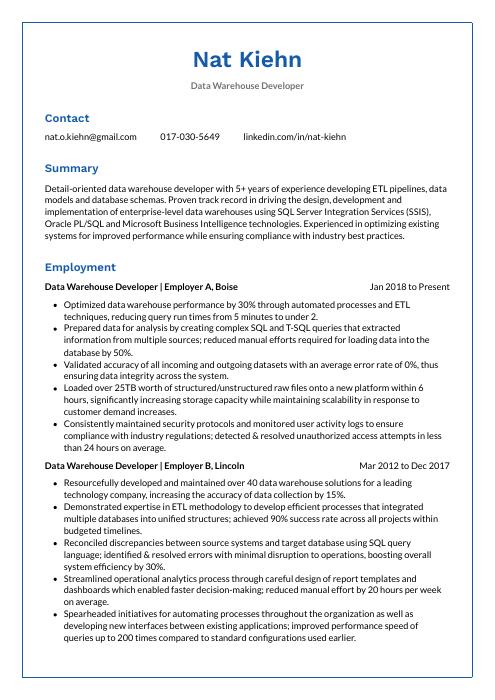 Markhor
Markhor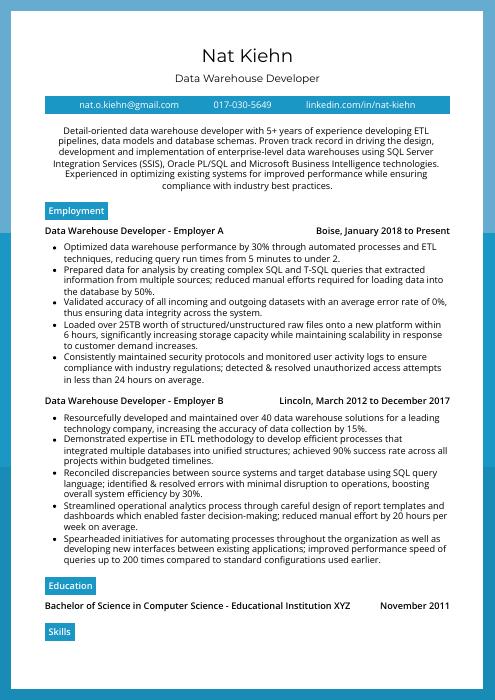 Rhea
Rhea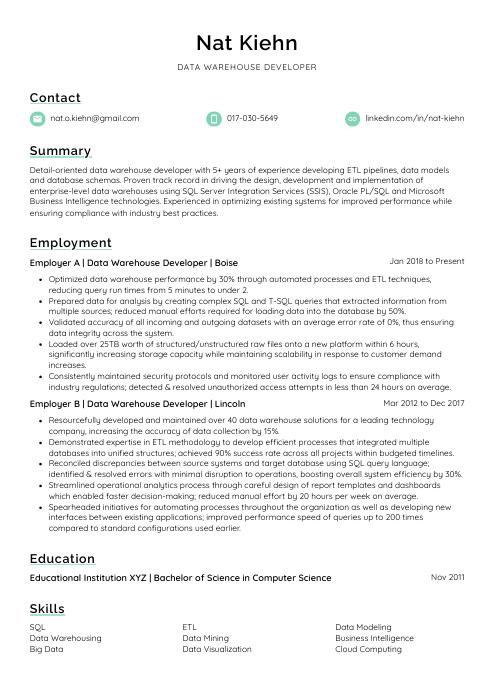 Lorikeet
Lorikeet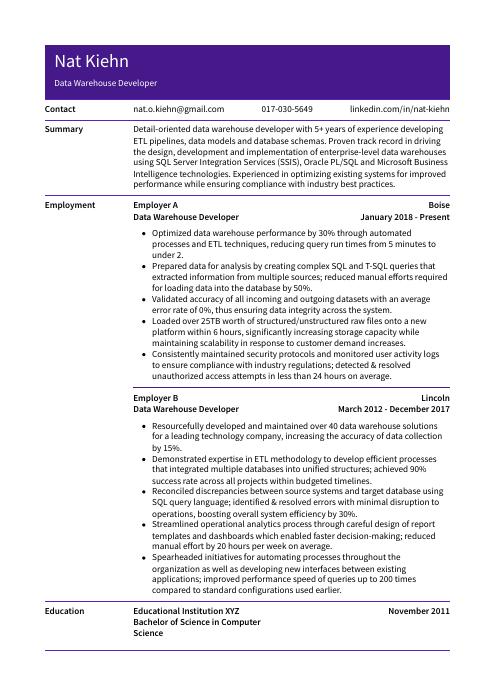 Pika
Pika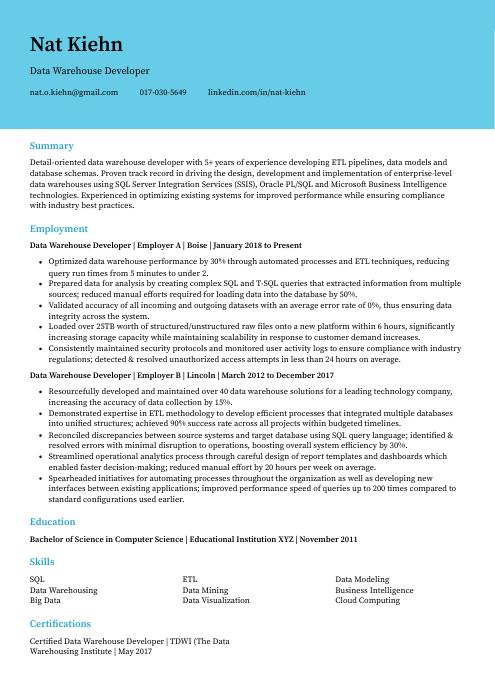 Dugong
Dugong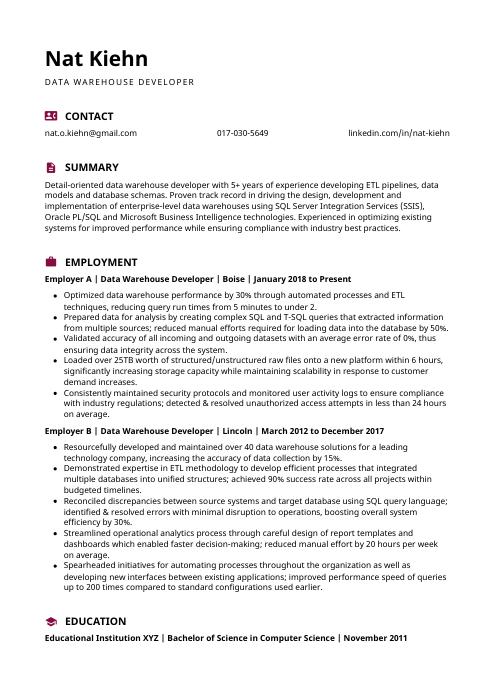 Hoopoe
Hoopoe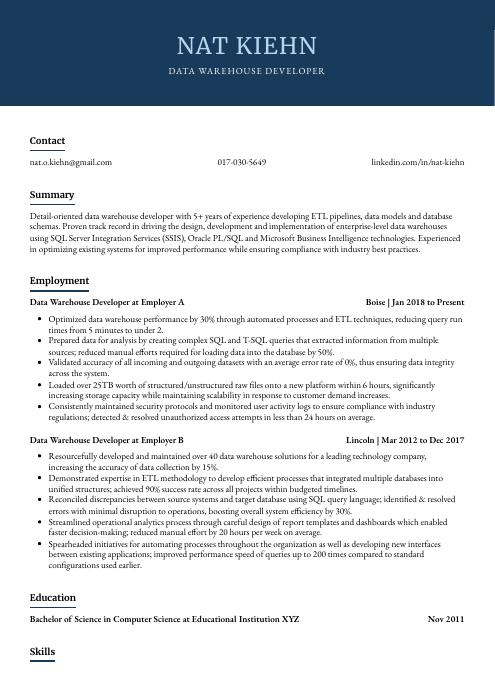 Bonobo
Bonobo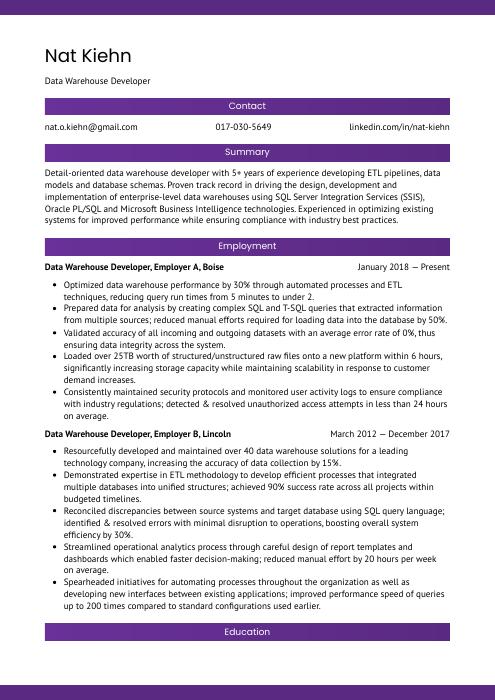 Jerboa
Jerboa Rezjumei
Rezjumei
